Jump to: Previous Designs | Introduction of Roosevelt Dimes | FDR: History and Milestones | Other Presidents in US Coinage | FAQs
President Franklin Delano Roosevelt, the 32nd president of the United States, has appeared on the dime since 1946, replacing the long-standing image of Lady Liberty.

Key Takeaways
-
President Franklin Delano Roosevelt has appeared on the U.S. dime since 1946, honoring his leadership during the Great Depression and World War II, and his connection to the March of Dimes polio campaign.
-
Before 1946, the dime featured Lady Liberty in several designs (Draped Bust, Capped Bust, Seated Liberty, Barber, and Mercury) together with the bald eagle, reflecting American ideals of freedom and courage.
-
The modern dime’s obverse displays Roosevelt with LIBERTY and IN GOD WE TRUST, while the reverse shows a torch flanked by an olive branch and oak branch, symbolizing liberty, peace, and strength.
-
The dime, like other U.S. coins, embodies national values and history, with earlier designs emphasizing Liberty and the bald eagle, reflecting the American identity.
|
Years in Use |
Design Name / Common Name |
Figure Depicted |
Notes |
Obverse and Reverse Designs |
|---|---|---|---|---|
|
1796–1807 |
Draped Bust |
Lady Liberty |
Flowing hair, ribbon, and drapery, small eagle on reverse (1796–97), then heraldic eagle (1798–1807). |
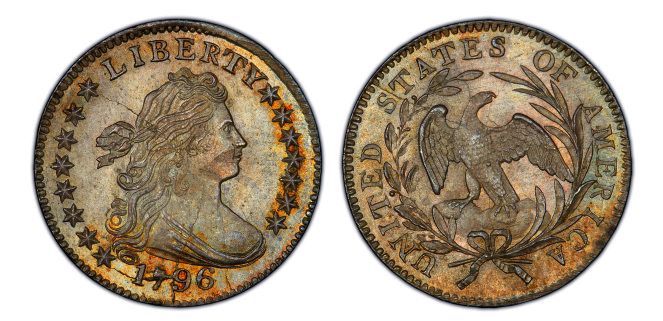  |
|
1809–1837 |
Capped Bust |
Lady Liberty |
Liberty with a Phrygian (freedom) cap, value “10C” first appears on reverse. |
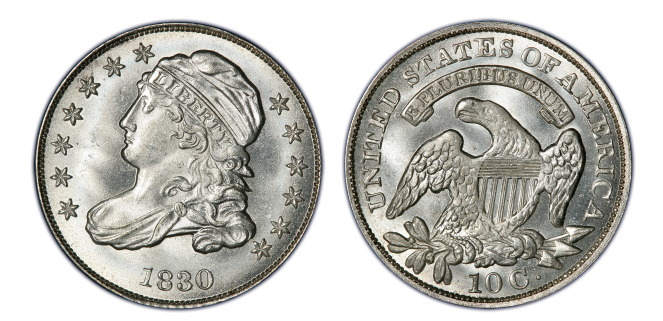 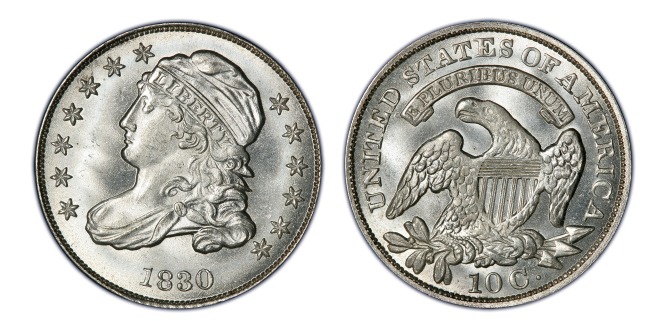 |
|
1837–1891 |
Seated Liberty |
Lady Liberty |
Liberty seated on a rock holding a shield and pole. |
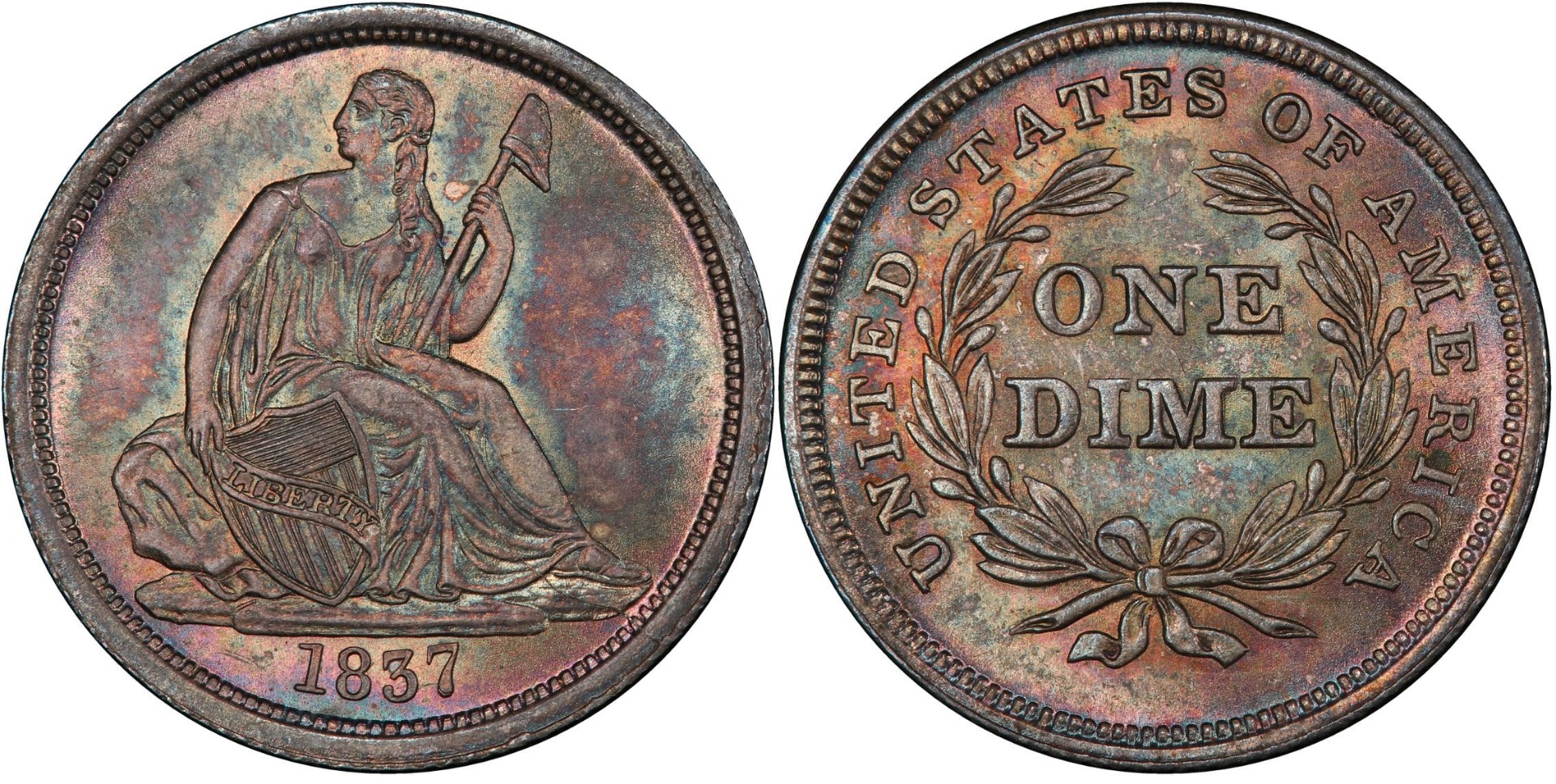 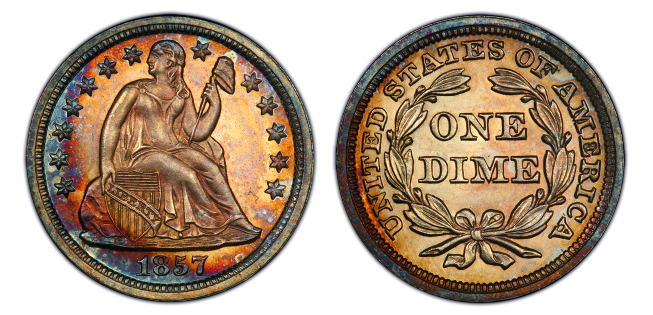
|
|
1892–1916 |
Barber Dime |
Lady Liberty |
Named for engraver Charles E. Barber; Liberty with a laurel wreath. |
 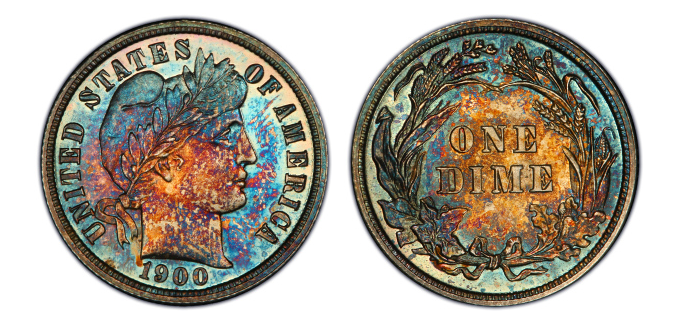
|
|
1916–1945 |
Winged Liberty Head (“Mercury Dime”) |
Lady Liberty (mistaken for the Roman God Mercury) |
Liberty with a winged cap symbolizing freedom of thought; nickname "Mercury Dime" stuck with collectors. |
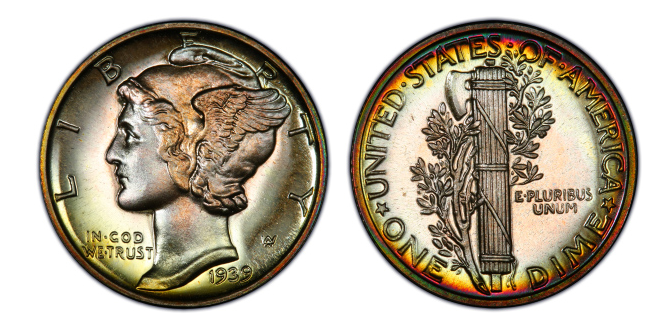  |
|
1946–Present |
Roosevelt Dime |
Franklin Delano Roosevelt |
Honors Roosevelt and his role in founding the March of Dimes. |
  |
Who appears on the dimes?
The dime was first issued by the U.S. Mint in 1796 and has seen many design changes. Early versions featured Lady Liberty on the obverse as a symbol of freedom, with a bald eagle on the reverse symbolizing strength and courage.
Today, the obverse shows President Franklin D. Roosevelt, while the reverse displays a torch flanked by an olive branch and an oak branch, symbolizing liberty, peace, strength, and independence.
These one-tenth coins were first made out of silver and copper. Silver coins were issued until 1965, when the Coinage Act removed silver from circulating dimes.
Below are images showing each of the dime designs issued in the United States from 1796 to the present.
Draped Bust Dime (1796 - 1807)

The dimes minted from 1796 through 1807 display the Draped Bust Design.
The reverse featured an eagle within a wreath, later modified with a shield on its breast, a ribbon inscribed E PLURIBUS UNUM, and arrows and an olive branch in its talons.
The words UNITED STATES OF AMERICA encircle the image, with no indication of denomination or value.
Capped Bust Dime (1809 - 1837)

Introduced in 1809, the Capped Bust dime resembled the half-dollar design of 1807. The obverse shows Liberty in a cloth cap inscribed LIBERTY, with flowing tresses and a draped bust secured by a clasp. Seven stars appear to the left, six to the right, and the date below.
The reverse of the coin design features an eagle on a branch holding arrows, with E PLURIBUS UNUM on a scroll above and UNITED STATES OF AMERICA and 10C. around the border. Its 18.8 mm planchet distinguishes it from the smaller 17.9 mm format introduced in 1828. Dimes were struck from 1809 to 1827, though not every year.
Seated Liberty Dime (1837 - 1891)

In 1860, the dime’s design changed: the Liberty Seated obverse lost its stars, replaced by UNITED STATES OF AMERICA, while the reverse gained a larger wreath enclosing ONE DIME. This style lasted through 1891, with notable scarce issues, including early 1870s Carson City pieces.
In 1873, the dime’s weight rose from 38.4 to 38.58 grains (2.5 g). To mark the change, arrowheads flanked the date in 1873–1874 issues; earlier 1873 dimes lack arrows. After 1874, arrows were removed, though the design otherwise stayed the same.
Barber Dime (1892 - 1916)

In 1892, the dime, quarter, and half-dollar denominations were redesigned.
Known as the Barber dime, the ten-cent denomination featured on the obverse Lady Liberty facing right, wearing a Phrygian cap and a laurel wreath, with the word LIBERTY in tiny letters in a band above her forehead.
The inscription UNITED STATES OF AMERICA surrounds the image, with the date below. The reverse features a large wreath enclosing the words ONE DIME.
Winged Liberty Head (1916 - 1945)

In 1916, A.A. Weinman’s new design replaced the Barber dime. It featured Liberty in a winged cap, earning the nickname “Mercury Dime” for its resemblance to the Roman god. The reverse shows a fasces with an olive branch, symbolizing peace and strength. The Mercury Dime remains one of the most popular U.S. coins.
Introduction of the Roosevelt Dimes

The U.S. Mint released the Roosevelt Dime on January 30, 1946, to honor his birthday.
Designed by John R. Sinnock, the Roosevelt dime has featured Roosevelt’s left-facing bust (a common artistic tradition for presidential portraits) since 1946, with the initials “JS” below. 1964 was the last silver issue; from 1965, dimes shifted to a copper-nickel clad composition.
The obverse bears LIBERTY, IN GOD WE TRUST, and the date. The reverse shows a torch flanked by an olive and oak leaves, symbolizing liberty, peace, and strength, with inscriptions UNITED STATES OF AMERICA, E PLURIBUS UNUM, and the legal tender value of ONE DIME. Circulating and uncirculated coins come from Denver and Philadelphia, while San Francisco strikes proofs.
Franklin Roosevelt: History and Milestones
“The only thing we have to fear is fear itself.”
Franklin Delano Roosevelt, or FDR, served as the 32nd American President from 1933 to 1945. During his term in office, he faced a deep economic depression.
To fight off the crisis, Roosevelt passed several laws and executive orders, known as the New Deal, that managed to relieve struggling farmers and the unemployed while, at the same time, providing economic growth.
In addition to assuming the Presidency at the depth of the Great Depression, he also led the country through the majority of World War II.
Many people say Franklin D. Roosevelt helped the American people regain faith in themselves.
The challenges of his presidency was just the tip of the iceberg.
Roosevelt fell ill with polio when he was 39 years old after spending a vacation with his family in New Brunswick in August 1921. In other words, during his eight years in the oval office, Roosevelt also had to endure and fight a disabling and life-threatening disease.
Unfortunately, on April 12, 1945, while at Warm Springs, Georgia, Roosevelt died of a cerebral hemorrhage.
The Roosevelt Dime
After his death, the U.S. Congress decided to honor President Roosevelt by portraying him on a coin's face.
The dime was chosen because of its close relation to the establishment of the March of Dimes, a program organized by the National Foundation for Infantile Paralysis.
The intention was to raise funds for research to find a cure for polio. Essentially, people supported the program by buying Lapel pins for 10 cents (a dime).
The program kicked off in the weeks leading up to Roosevelt's birthday on January 30, 1938, when radio personality Eddie Cantor encouraged Americans to donate their loose change to Roosevelt's cause, urging listeners to send dimes to the White House.
The campaign was an astounding success and raised approximately 2,680,000 dimes (or $268,000), which prompted Roosevelt to broadcast his gratitude to the nation on TV:
"During the past few days, bags of mail have been coming, literally by the truckload, to the White House. Yesterday, between forty and fifty thousand letters came to the mailroom of the White House. Today, an even greater number — how many I cannot tell you — for we can only estimate the actual count by counting the mail bags. In all the envelopes are dimes and quarters and even dollar bills — gifts from grown-ups and children — mostly from children who want to help other children get well. … It is glorious to have one's birthday associated with a work like this." — Franklin D. Roosevelt in his birthday celebration broadcast on January 30, 1938
Roosevelt's Fight Against Polio
Polio was a diagnosis that didn't discourage Roosevelt. He had already been elected to the New York State Senate in 1910, served as Assistant Secretary of the Navy, and was also on the Democratic ticket as vice president in 1920.
In 1926, he began visiting warm springs to swim in their thermal waters as a treatment for polio. In the same year, he invested his personal money to purchase the Warm Springs property in Georgia and, the following year, started the Georgia Warm Springs Foundation, named after the therapeutic springs he had used to try to fight polio.
In 1927, the American Orthopaedic Association recommended that Warm Springs be designated a permanent hydrotherapeutic center.
The Polio vaccine was only declared safe and effective in 1955. By 1957 the incidence of polio in the United States had dropped by 90 percent. Franklin Roosevelt sadly didn't have the chance to be cured, but thanks to his efforts, thousands of Americans and children around the world were saved.
His contribution to the treatment of polio was indeed worthy of recognition on a United States coin.
Other Presidents in American Coinage
Nowadays, the obverse of most American circulating coins features the bust of a former U.S. President.
The first one to receive that honor was Abraham Lincoln back in 1909. He is the face on the penny.
Thomas Jefferson is the President who is on the nickel. As one of the Founding Fathers of the United States, he played a key role in drafting the Declaration of Independence and later served as the nation's third president.
George Washington, the first U.S. President, appears on the quarter, while the Half-Dollar coin features John F. Kennedy.
Final Words
In this article, we explored the evolution of the dime’s design. The symbols on the Dime reflect the ideals of a nation that values freedom, peace, and resilience, and stands prepared to protect those principles.
It is also fitting that President Franklin D. Roosevelt appears on the dime. His leadership guided the country through the Great Depression and World War II, leaving a legacy of courage and compassion. His association with the March of Dimes campaign, which raised funds to fight polio, further connected him to this coin, making his portrait not only a tribute to his presidency but also to his humanitarian spirit.
As Roosevelt dimes continue to circulate in our daily lives, they remind us not only of national strength but also of the enduring impact of leadership grounded in resilience and empathy.
Frequently Asked Questions (FAQ)
Who is featured on the dime, and when was it first created?
The first dime, introduced after the Coinage Act of 1792, featured the Draped Bust design of Lady Liberty with flowing hair, a ribbon, and drapery. Lady Liberty is a metaphorical figure, inspired by the Roman goddess of liberty, Libertas. For over a century, U.S. coins have depicted Liberty to symbolize the most important national value and distinguish themselves from Britain’s tradition of portraying monarchs.
What makes the dime different from other U.S. coins?
Besides the obvious differences like design and face value, the main difference between the Dime from other coins lies in its size and weight. Dimes are the smallest of the four coins, the nickel, quarter, and penny: it weighs 2.268 grams, with a diameter of 0.705 inches (17.91 mm), and a thickness of 1.35 mm.
What did the earliest dimes look like when they were first minted?
The first dimes, minted in 1796, featured Liberty with flowing hair, a ribbon, and drapery on the obverse, with LIBERTY above, the date below, and 13 stars (the 1797 showing either 13 or 16). The reverse showed a small eagle on a cloud within an open wreath tied with a bow, surrounded by UNITED STATES OF AMERICA. No denomination appeared until the Capped Bust dime in 1809.
Why was the Mercury dime called “Mercury” if it didn’t show the Roman god?
Liberty is shown wearing a winged cap, much like the Roman god Mercury. Combined with the profile view, which makes the figure’s gender less obvious, this led to the coin being popularly called the “Mercury dime.”
What was the Barber dime, and how long was it used?
The Barber dime was a ten-cent coin issued by the United States from 1892 to 1916. It is named after its designer, the Chief Engraver Charles E. Barber, and was used for 25 years before being replaced by the Winged Liberty Head.
When did Roosevelt first appear on the dime, and why?
Roosevelt first appeared on the dime in 1946. He was chosen not only for his leadership during the Great Depression and World War II, but also for his close association with the March of Dimes campaign, which raised funds to fight polio. Since the public donated dimes to support this cause, placing Roosevelt on the ten-cent coin was seen as a fitting tribute after his death in 1945.
What do the symbols on the modern dime represent?
On the modern dime, the obverse shows President Franklin D. Roosevelt along with the inscriptions LIBERTY and IN GOD WE TRUST, reflecting the nation’s founding ideals. The reverse carries a torch, symbolizing liberty, flanked by an olive branch for peace and an oak branch for strength.
How have dime designs evolved throughout American history?
Dime designs have evolved from allegorical images of Liberty paired with the bald eagle to portraits of President Franklin D. Roosevelt. Early types included the Draped Bust (1796–1807), Capped Bust (1809–1837), Seated Liberty (1837–1891), and Barber dime (1892–1916). In 1916, the Winged Liberty Head, better known as the Mercury dime, was introduced, followed by the Roosevelt dime in 1946, which remains in use today.
Why do coin collectors value certain dimes more than others?
Coin collectors value certain dimes more than others based on factors such as rarity, historical significance, condition, and minting errors. In general, a dime with unique characteristics, in excellent condition, and difficult to find will be worth more to collectors than a common, widely available example.
What is the cultural significance of the dime in American currency?
Like other American coins, the dime’s design elements reflect national values and principles. Lady Liberty appears in most of its early designs, echoing the ideals of freedom, much as the Statue of Liberty was originally conceived to celebrate the emancipation of enslaved people in the United States. For many, the monument’s most enduring symbolism is the advancement of liberty. Alongside Liberty, the bald eagle has often been featured as a representation of both freedom and strength. As the national bird and emblem of the United States, the eagle also appears on the Great Seal, reinforcing its cultural significance.


















